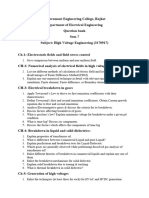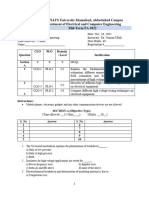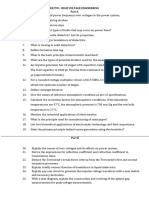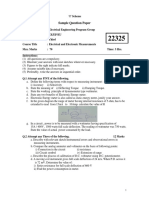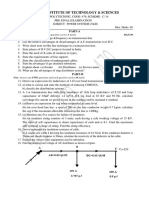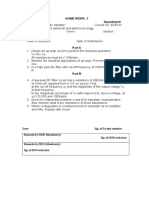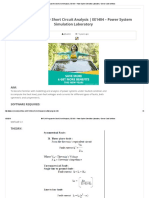0 ratings0% found this document useful (0 votes)
33 viewsCourse: M-TECH (EPS) Subject:High Voltage Engineering Max. Marks: 5 2 10
Course: M-TECH (EPS) Subject:High Voltage Engineering Max. Marks: 5 2 10
Uploaded by
M B Hemanth KumarThis document appears to be an exam for a M-Tech course in High Voltage Engineering. The exam contains short answer definitions questions worth 10 marks and longer answer questions worth 15 marks from which students must choose 3. Some of the topics covered include loss factor, lightning phenomenon, system faults, DC resistivity, impulse currents, testing of isolators and circuit breakers, insulation coordination principles, using an oscilloscope for impulse measurements, partial discharge measurements, and natural causes of over voltages.
Copyright:
© All Rights Reserved
Available Formats
Download as DOCX, PDF, TXT or read online from Scribd
Course: M-TECH (EPS) Subject:High Voltage Engineering Max. Marks: 5 2 10
Course: M-TECH (EPS) Subject:High Voltage Engineering Max. Marks: 5 2 10
Uploaded by
M B Hemanth Kumar0 ratings0% found this document useful (0 votes)
33 views1 pageThis document appears to be an exam for a M-Tech course in High Voltage Engineering. The exam contains short answer definitions questions worth 10 marks and longer answer questions worth 15 marks from which students must choose 3. Some of the topics covered include loss factor, lightning phenomenon, system faults, DC resistivity, impulse currents, testing of isolators and circuit breakers, insulation coordination principles, using an oscilloscope for impulse measurements, partial discharge measurements, and natural causes of over voltages.
Original Description:
hve
Original Title
HVE II MID QP
Copyright
© © All Rights Reserved
Available Formats
DOCX, PDF, TXT or read online from Scribd
Share this document
Did you find this document useful?
Is this content inappropriate?
This document appears to be an exam for a M-Tech course in High Voltage Engineering. The exam contains short answer definitions questions worth 10 marks and longer answer questions worth 15 marks from which students must choose 3. Some of the topics covered include loss factor, lightning phenomenon, system faults, DC resistivity, impulse currents, testing of isolators and circuit breakers, insulation coordination principles, using an oscilloscope for impulse measurements, partial discharge measurements, and natural causes of over voltages.
Copyright:
© All Rights Reserved
Available Formats
Download as DOCX, PDF, TXT or read online from Scribd
Download as docx, pdf, or txt
0 ratings0% found this document useful (0 votes)
33 views1 pageCourse: M-TECH (EPS) Subject:High Voltage Engineering Max. Marks: 5 2 10
Course: M-TECH (EPS) Subject:High Voltage Engineering Max. Marks: 5 2 10
Uploaded by
M B Hemanth KumarThis document appears to be an exam for a M-Tech course in High Voltage Engineering. The exam contains short answer definitions questions worth 10 marks and longer answer questions worth 15 marks from which students must choose 3. Some of the topics covered include loss factor, lightning phenomenon, system faults, DC resistivity, impulse currents, testing of isolators and circuit breakers, insulation coordination principles, using an oscilloscope for impulse measurements, partial discharge measurements, and natural causes of over voltages.
Copyright:
© All Rights Reserved
Available Formats
Download as DOCX, PDF, TXT or read online from Scribd
Download as docx, pdf, or txt
You are on page 1of 1
ANNAMACHARYA INSTITUTE OF TECHONOLGY& SCIENCES - HYDERABAD
DEPARTMENT OF ELECTRICAL & ELECTRONICS ENGINEERING
M.TECH I YEAR II MID-2016
Course: M-TECH (EPS)
Subject:HIGH VOLTAGE ENGINEERING
Answer all the questions
Marks: 5*2=10
Time: 2 hours
max.
1.Define the following
a) loss factor
b) Lightning phenomenon
c) system faults and other abnormal conditions
d) D.C Resistivity
e) Impulse currents
Answer any three questions
Marks: 3*5=15
max.
1. Explain Testing of Isolators and circuit breakers testing of cables .
2. Write about Principles of Insulation Coordination on High voltage and Extra
High Voltage power systems.
3. Explain Oscilloscope for impulse voltage and current measurements. .
4. Explain about Partial discharge measurements
5. Write the Natural causes for over voltages.
You might also like
- Journal of Theoretical and Applied Information TechnologyDocument1 pageJournal of Theoretical and Applied Information TechnologyM B Hemanth KumarNo ratings yet
- Hve Mid Sem 1Document1 pageHve Mid Sem 1Arohi AnandNo ratings yet
- NR 320204 HIgh Voltge EngineeringDocument4 pagesNR 320204 HIgh Voltge EngineeringSrinivasa Rao GNo ratings yet
- 52129-mt - Extra High Voltage TransmissionDocument2 pages52129-mt - Extra High Voltage TransmissionSRINIVASA RAO GANTANo ratings yet
- Electrical Power Distribution & Utilization (Ee-353) : Practical Work BookDocument53 pagesElectrical Power Distribution & Utilization (Ee-353) : Practical Work BookKishore KrishnaNo ratings yet
- Eet 3361 Power Systems Engineering 1Document3 pagesEet 3361 Power Systems Engineering 1bernardmwangi055No ratings yet
- Measurement and InstrumentationDocument2 pagesMeasurement and InstrumentationThameem AbbasNo ratings yet
- PQE Int 1 QPDocument3 pagesPQE Int 1 QPBalaji ThiyagarajanNo ratings yet
- Sem V-Electrical Circuit and Network SkillsDocument3 pagesSem V-Electrical Circuit and Network Skillsalkitab46No ratings yet
- Google 11Document2 pagesGoogle 11Suraj TiwariNo ratings yet
- BEEE CivilDocument1 pageBEEE CivilkannanNo ratings yet
- HVE-Question BankDocument2 pagesHVE-Question Bankjadavsagar7874No ratings yet
- Quiz Bee Reviewer - ElecsDocument6 pagesQuiz Bee Reviewer - ElecsaclNo ratings yet
- Electrical Technology 1st SemDocument20 pagesElectrical Technology 1st SemArslan Shani100% (1)
- HV MidDocument3 pagesHV MidKhhakwani BrothersNo ratings yet
- Mid - Ii: Annamacharya Institute of Technology and Sciences-HyderabadDocument1 pageMid - Ii: Annamacharya Institute of Technology and Sciences-HyderabadM B Hemanth KumarNo ratings yet
- Et 2019 OctDocument2 pagesEt 2019 OctSYED'SNo ratings yet
- Ec I Model QPDocument3 pagesEc I Model QPNoddy SenNo ratings yet
- rr310203 Power Systems IIDocument8 pagesrr310203 Power Systems IISRINIVASA RAO GANTANo ratings yet
- Techno Eleq3 enDocument74 pagesTechno Eleq3 eneugeni madaNo ratings yet
- EE3701Document2 pagesEE3701santhosheee19973No ratings yet
- Sl. No Major Topics No. of Periods Weighta Ge of Marks Short Answer Questio Ns Essay Questi OnsDocument5 pagesSl. No Major Topics No. of Periods Weighta Ge of Marks Short Answer Questio Ns Essay Questi OnsAditya KoppanaNo ratings yet
- R09-High Voltage Engineering & Insulation Co-OrdinationDocument1 pageR09-High Voltage Engineering & Insulation Co-OrdinationPradeepChandraVarmaMandapatiNo ratings yet
- Lab ManualDocument37 pagesLab ManualArslanNo ratings yet
- Sample Question Paper Electrical and Electronic MeasurementDocument4 pagesSample Question Paper Electrical and Electronic MeasurementDeeo Dhadiwal0% (1)
- Sarhad University, Peshawar: (Distance Education)Document1 pageSarhad University, Peshawar: (Distance Education)Mohsin IqbalNo ratings yet
- Electrical Past PaperDocument14 pagesElectrical Past PaperdiciiuniverseNo ratings yet
- QB KEE101T ElectricalDocument15 pagesQB KEE101T Electricalplantforest16No ratings yet
- Laqshya Institute of Technology & Sciences: Part-ADocument1 pageLaqshya Institute of Technology & Sciences: Part-Asamson4314No ratings yet
- Shanmuganathan Engineering College (An ISO 9001:2008 Certified Institution) Arasampatti - 622 507Document2 pagesShanmuganathan Engineering College (An ISO 9001:2008 Certified Institution) Arasampatti - 622 507Anonymous gAVMpR0aNo ratings yet
- Power SystemsDocument47 pagesPower Systemsmanish_chaturvedi_6No ratings yet
- Electrical Power Distribution & Utilization: Lab ManualDocument40 pagesElectrical Power Distribution & Utilization: Lab ManualUzair HussainNo ratings yet
- 9.electrical - Circuits - and - Network - Skills - SecDocument4 pages9.electrical - Circuits - and - Network - Skills - Secalkitab46No ratings yet
- Mce 302a (40333)Document4 pagesMce 302a (40333)Koushik DuttaNo ratings yet
- HV Sheets (2015) A FDocument7 pagesHV Sheets (2015) A FMANS عسيريNo ratings yet
- Course: M-TECH - P.E Subject: PQ Answer The Following Question Compulsory 16 MDocument1 pageCourse: M-TECH - P.E Subject: PQ Answer The Following Question Compulsory 16 MM B Hemanth KumarNo ratings yet
- Pee QPDocument1 pagePee QPM B Hemanth KumarNo ratings yet
- Name of The Faculty Member: Course No: ECE131 Course Title: Basic Electrical and Electronics Engg Class: B.tech Term:I Section: Batch:2010 Max. Marks: 25 Date of Allotment: Date of SubmissionDocument1 pageName of The Faculty Member: Course No: ECE131 Course Title: Basic Electrical and Electronics Engg Class: B.tech Term:I Section: Batch:2010 Max. Marks: 25 Date of Allotment: Date of SubmissionAkash NegiNo ratings yet
- Electrical Systems 4232Document3 pagesElectrical Systems 4232Mohamed RiyaazNo ratings yet
- 52131-mt - High Voltage EngineeringDocument2 pages52131-mt - High Voltage EngineeringSRINIVASA RAO GANTANo ratings yet
- هندسه قدرهDocument65 pagesهندسه قدرهIraqi for infoNo ratings yet
- DC Circuit Assignment BmuDocument6 pagesDC Circuit Assignment Bmujagannath.b.mohapatra.27No ratings yet
- Google 16Document2 pagesGoogle 16Suraj TiwariNo ratings yet
- Experiment No - 3Document11 pagesExperiment No - 3aadityagadwal03No ratings yet
- Ece PaperDocument2 pagesEce Papersmohan_4uNo ratings yet
- Department of Electrical Engineering: End Chapter ProblemsDocument4 pagesDepartment of Electrical Engineering: End Chapter ProblemsWasif ImadiNo ratings yet
- 19EEE181 ManualDocument39 pages19EEE181 ManualabcdNo ratings yet
- Electrical Technology 3 Correct PubDocument11 pagesElectrical Technology 3 Correct PubNGOUNENo ratings yet
- FinalExamination OpticsDocument2 pagesFinalExamination OpticsMaha RaoufNo ratings yet
- Conventional and CAD of Electrical Machines EEE023Document3 pagesConventional and CAD of Electrical Machines EEE023Dheeraj KumarNo ratings yet
- Ee-116 Principles of Electrical Engineering - 2014Document96 pagesEe-116 Principles of Electrical Engineering - 2014hmxa91No ratings yet
- Assignment ECEG-4261 Microelectronic Devices and Circuits (MDC)Document7 pagesAssignment ECEG-4261 Microelectronic Devices and Circuits (MDC)erenaNo ratings yet
- 08 r05310203 Power Systems IIDocument8 pages08 r05310203 Power Systems IIandhracollegesNo ratings yet
- SYLLABUSDocument2 pagesSYLLABUSNithin KumarNo ratings yet
- EE-101 Electrical Technology) - 2012 Mech PDFDocument79 pagesEE-101 Electrical Technology) - 2012 Mech PDFPonteyoss KonjokelossNo ratings yet
- Beee Lecture Notes 2018 2019Document111 pagesBeee Lecture Notes 2018 2019Nanda KumarNo ratings yet
- Shri Sai Taj Polytechnic, Nagpur: Session: 2015-2016 First Class TestDocument1 pageShri Sai Taj Polytechnic, Nagpur: Session: 2015-2016 First Class Testsahil satputeNo ratings yet
- Following Problems, Unless Otherwise Stated, Assume Μncox = 200 Μa/V2, Μpcox =100 A/V2, And Vth = 0.4 V For Nmos Devices And −0.4 V For Pmos Devices, Where NecessaryDocument5 pagesFollowing Problems, Unless Otherwise Stated, Assume Μncox = 200 Μa/V2, Μpcox =100 A/V2, And Vth = 0.4 V For Nmos Devices And −0.4 V For Pmos Devices, Where Necessaryjorge yair moreno celisNo ratings yet
- r05320206 High Voltage EngineeringDocument4 pagesr05320206 High Voltage EngineeringSrinivasa Rao G88% (8)
- Introduction to Power System ProtectionFrom EverandIntroduction to Power System ProtectionRating: 5 out of 5 stars5/5 (1)
- Mid - Ii: Annamacharya Institute of Technology and Sciences-HyderabadDocument1 pageMid - Ii: Annamacharya Institute of Technology and Sciences-HyderabadM B Hemanth KumarNo ratings yet
- Time Table: Annamacharya Institue of Technology & Sciences - HyderabadDocument1 pageTime Table: Annamacharya Institue of Technology & Sciences - HyderabadM B Hemanth KumarNo ratings yet
- Important QuestionsDocument1 pageImportant QuestionsM B Hemanth KumarNo ratings yet
- Mid - Ii: Annamacharya Institute of Technology and Sciences-HyderabadDocument1 pageMid - Ii: Annamacharya Institute of Technology and Sciences-HyderabadM B Hemanth KumarNo ratings yet
- Matlab For SHRT Circuit AnalysisDocument6 pagesMatlab For SHRT Circuit AnalysisM B Hemanth KumarNo ratings yet
- Pee QPDocument1 pagePee QPM B Hemanth KumarNo ratings yet
- Electrical Technology Lab PracticeDocument2 pagesElectrical Technology Lab PracticeM B Hemanth KumarNo ratings yet
- International Journal of Emerging Technologies in Computational and Applied Sciences (IJETCAS)Document1 pageInternational Journal of Emerging Technologies in Computational and Applied Sciences (IJETCAS)M B Hemanth KumarNo ratings yet
- Curriculum C-14 FOR Diploma in Electrical & Electronics EngineeringDocument224 pagesCurriculum C-14 FOR Diploma in Electrical & Electronics EngineeringM B Hemanth KumarNo ratings yet
- Abedinpour 2007Document12 pagesAbedinpour 2007M B Hemanth KumarNo ratings yet
- Course: M-TECH - P.E Subject: PQ Answer The Following Question Compulsory 16 MDocument1 pageCourse: M-TECH - P.E Subject: PQ Answer The Following Question Compulsory 16 MM B Hemanth KumarNo ratings yet
- Presentations 1Document5 pagesPresentations 1Hari NairNo ratings yet
- ScimagojrDocument3 pagesScimagojrM B Hemanth KumarNo ratings yet











